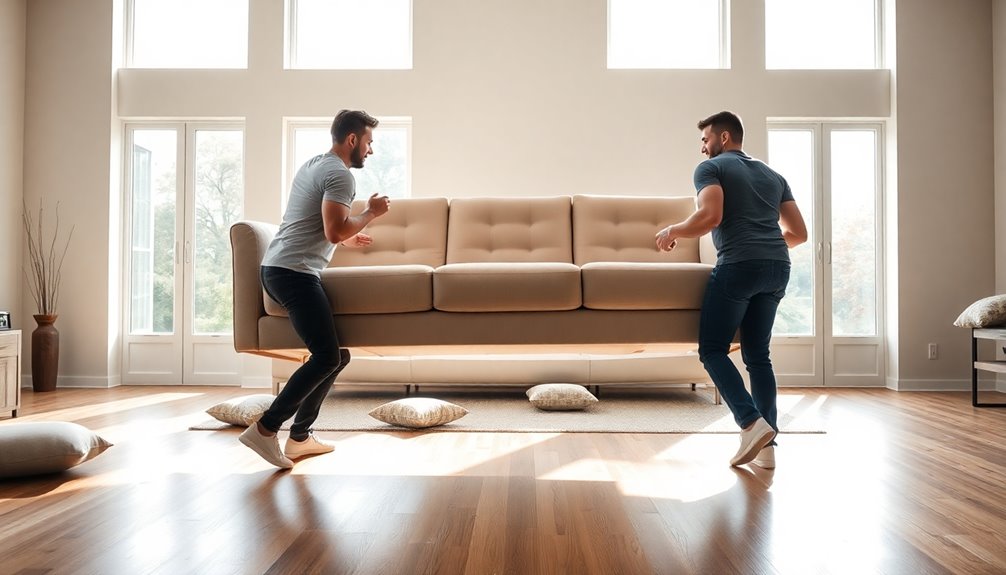To move a sofa, start by clearing the area around it. Remove cushions and any detachable parts to lighten the load. Use furniture sliders or a dolly for easier transport, and always lift with your legs to avoid injury. If navigating tight spaces, angle the sofa and tilt it gently. Wrap the sofa in moving blankets to protect it from scratches. Having a helper is crucial for balancing and maneuvering. Finally, ensure you secure it properly in your vehicle. There's plenty more to know about protecting your sofa during the move, so stick around for additional tips!
Key Takeaways
- Clear Pathway: Remove obstacles and furniture to create a clear path for moving the sofa to prevent accidents and damage.
- Disassemble if Possible: Take apart removable sections, such as legs or cushions, to make the sofa easier to handle and transport.
- Use Proper Lifting Technique: Bend at the knees and lift with your legs, keeping the sofa close to your body to avoid injury.
- Protect the Sofa: Use blankets or furniture pads to protect the sofa from scratches and damage during the move.
- Get Help: Enlist a friend or family member to assist in lifting and maneuvering the sofa safely through doorways and tight spaces.
Introduction
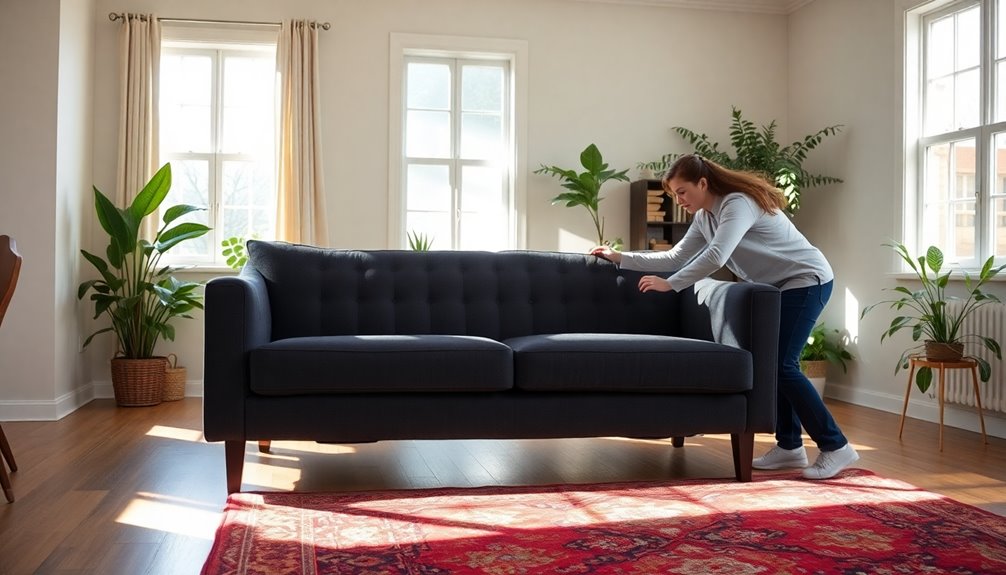
When you move a sofa, keeping it clean is just as important as the heavy lifting. Regular vacuuming and dusting will help maintain its appearance, while knowing the right cleaning techniques for the fabric can prevent damage. And if spills happen, treating them promptly can save you from long-lasting stains.
Routine Vacuuming and Dusting
To keep your sofa looking its best and to create a healthier living environment, routine vacuuming and dusting are essential. Regular vacuuming of your upholstery helps remove dust, pet hair, and allergens that can accumulate over time. Use a vacuum with an upholstery attachment to effectively clean the fabric surfaces without causing damage. Aim to vacuum at least once a week to maintain your sofa's appearance.
In addition to vacuuming, dusting the surface of your sofa with a microfiber cloth can eliminate surface dust and prevent it from settling into the fabric fibers. This simple step not only keeps your sofa clean but also contributes to a healthier indoor environment. By incorporating these practices into your weekly routine, you'll effectively prolong your sofa's lifespan and enhance its overall look.
For a more thorough clean, consider scheduling professional upholstery cleaning every 12 to 24 months, especially if your sofa sees heavy use. By staying on top of vacuuming and dusting, you'll ensure your sofa remains a comfortable and inviting centerpiece in your home. Additionally, using a vacuum equipped with HEPA filters can help reduce allergens in your living space, promoting better indoor air quality.
Fabric-Specific Cleaning Techniques
Cleaning your sofa is an essential task that requires attention to the specific fabric type it's made from. Knowing whether your sofa is leather, microfiber, or cotton will guide your cleaning approach. For leather sofas, use a damp cloth with a specialized leather cleaner. Be careful not to use excess water, as it can damage or dry out the material.
If you have microfiber sofas, mix water with mild detergent and apply it with a soft cloth. Gently scrub to avoid damaging the fabric. For cotton upholstery, spot cleaning is usually effective; a mixture of water and vinegar or a mild fabric cleaner works well. Just remember to check the manufacturer's care tag for specific instructions.
Before applying any cleaning solution to your sofa, always do a patch test in an inconspicuous area. This ensures the solution won't cause discoloration or damage to your furniture. Additionally, using essential oils can enhance the cleaning experience and provide a pleasant aroma to your living space. By taking these precautions, you can maintain the beauty and longevity of your sofa while ensuring it stays clean and fresh.
Treating Wine Spills Promptly
A wine spill can ruin your sofa's appearance if you don't act fast. First, grab a clean, dry cloth or paper towel and gently blot the spill—don't rub it, as that can spread the stain further. You'll want to absorb as much liquid as possible. Next, mix one part white vinegar with two parts water, and dab the stained area with this solution. The acidity helps neutralize the red wine.
For stubborn stains, apply a bit of dish soap mixed with hydrogen peroxide, letting it sit for a few minutes before blotting with a clean cloth. Always remember to test any cleaning solution on a hidden area of the fabric to avoid discoloration. After treating the stain, rinse the area with cold water and blot again to remove any residue. Let it air dry completely.
If you're in a situation where you need help moving a couch or heavy furniture around your living space, consider using moving blankets and bubble wrap to protect your items while cleaning. Acting quickly can save your sofa from permanent damage!
Avoiding Direct Sunlight
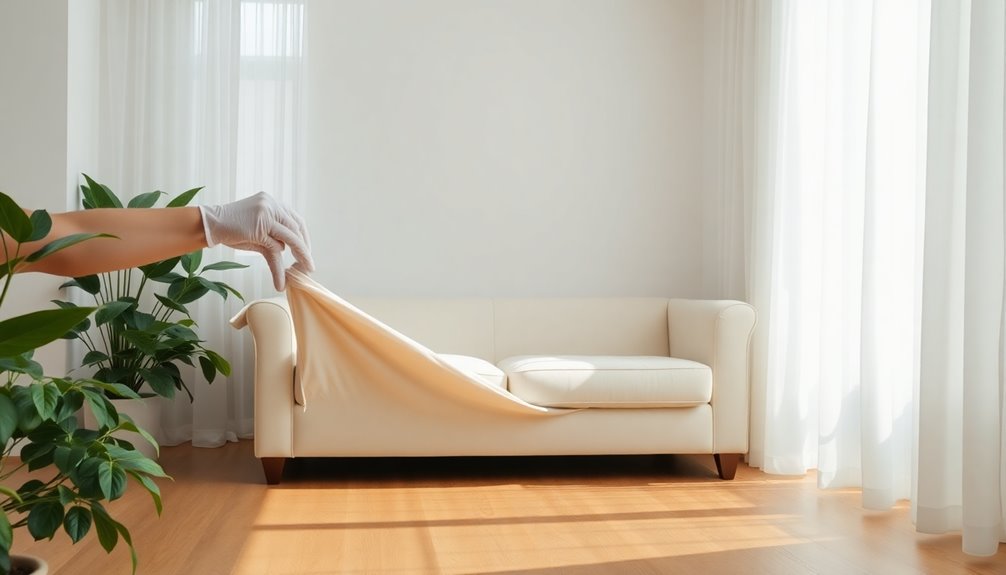
When you're setting up your sofa, keeping it out of direct sunlight is crucial. Not only can sunlight fade fabrics, but it can also weaken the materials over time. Opt for scratch-resistant and breathable fabric covers, and consider using protective furniture covers to keep your sofa looking great for years to come.
Use Scratch-Resistant Fabrics
To keep your sofa looking fresh and vibrant, opt for scratch-resistant fabrics like microfiber or synthetic blends. These materials are designed to maintain appearance by reducing visible wear and tear from daily use. Fabrics that are tightly woven are particularly durable, making them less likely to snag or fray, which is essential for homes with pets or active households.
In addition to choosing these resilient fabrics, consider incorporating protective covers or throws. They act as an extra layer of defense against scratches and stains, especially in high-traffic areas. Regularly rotating cushions is another effective strategy; it helps distribute wear evenly across your sofa, extending the lifespan of both the fabric and the structure.
Select Breathable Fabric Covers
Selecting breathable fabric covers is essential for protecting your sofa from moisture and heat buildup, which can lead to mildew or mold. Opt for materials like cotton or linen that promote air circulation, preventing moisture buildup and ensuring your sofa remains fresh. Steer clear of plastic covers; they trap humidity and heat, potentially damaging your upholstery over time.
When you choose covers, look for UV resistant options to guard against fading caused by direct sunlight exposure, especially in bright areas of your home. This will help maintain the vibrant colors and patterns of your sofa.
Additionally, consider selecting machine washable covers for easy maintenance. This feature allows you to keep your sofa clean and free from dust and allergens without much hassle.
Lastly, invest in secure covers with ties or elastic hems. These will keep your covers in place, preventing them from slipping or blowing away in breezy conditions. By following these guidelines, you'll ensure your sofa stays protected and looking great for years to come.
Use Protective Furniture Covers
Using protective furniture covers is a smart way to shield your sofa from dust and dirt while keeping it safe from the harmful effects of direct sunlight. Choose covers specifically designed with UV protection to minimize fading and damage caused by sun exposure. This is crucial, as prolonged sunlight can degrade your upholstery over time.
Make sure the cover fits snugly to prevent slipping, especially during transport. A loose cover can expose your sofa to dust, dirt, and moisture, negating its protective benefits. Opt for breathable protective furniture covers that allow air circulation, as this helps prevent mold and mildew buildup underneath.
Consider using covers made from water-resistant materials to guard against spills and moisture. This feature is especially important if you're moving your sofa or storing it in a potentially damp environment. Regularly check the condition of your sofa beneath the cover, ensuring that no moisture or pests have caused any damage while it's protected. By taking these precautions, you'll keep your sofa in excellent condition for years to come.
Cushion Replacement and Repair
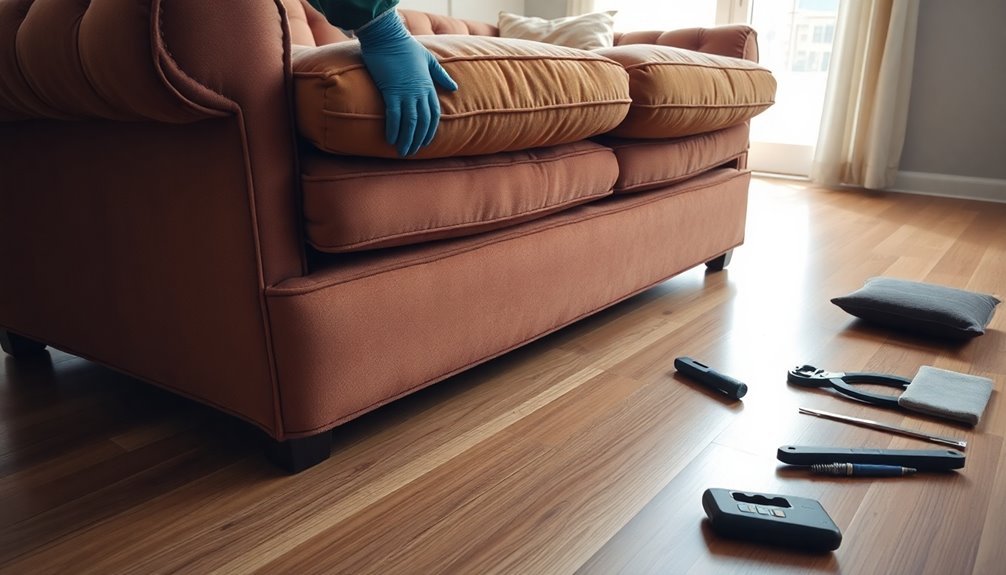
When it comes to cushion replacement and repair, you'll want to assess any frame weakness or damage first. Reupholstering can give your sofa a fresh look, while new cushion inserts can enhance comfort. Let's explore how to tackle these updates effectively.
Frame Weakness and Damage
Sofa frames can weaken over time, leading to cracks or broken joints that might compromise the entire piece. It's crucial to inspect the frame regularly for signs of frame weakness. If you spot any cracks, don't ignore them; addressing these issues promptly can prevent further structural damage. For minor cracks, you can easily repair them using wood glue and clamps. This method ensures a strong bond and stability once the glue dries.
If you notice more significant weaknesses, consider reinforcing the frame with additional brackets or corner blocks. This added support can significantly improve durability and help prevent future breakage. Additionally, keep an eye on the cushioning, as worn-out foam can affect comfort and the overall integrity of the sofa. Regular maintenance, such as using energy-efficient appliances, can also contribute to a better living environment by reducing energy consumption in the home.
To maintain your sofa's longevity, make it a habit to check both the frame and cushioning regularly. By practicing proactive maintenance, you can extend the lifespan of your sofa and ensure it remains a comfortable seating option for years to come. Remember, a well-maintained sofa not only looks better but also feels better!
Reupholstering for a Fresh Look
Inspecting your sofa's frame for damage is just the first step in maintaining its overall appeal. Once you've ensured there's no structural damage, you can dive into the reupholstering process. Start by removing the old fabric and padding, which gives you access to worn-out cushions that need replacing. When choosing new cushions, opt for high-density foam; it provides the comfort and durability you desire for your sofa.
Next, select a fabric that complements your decor style while being durable and easy to clean. Microfiber or synthetic blends are great choices, offering both a fresh look and practicality. Remember, the right fabric can transform your sofa and elevate the entire room's vibe. Incorporating natural materials into your fabric choices can enhance the rustic charm that complements modern farmhouse aesthetics.
Reupholstering can be a significant investment, ranging from $600 to $2,000, depending on your fabric choice and the complexity of the work. However, this upgrade can breathe new life into your furniture, making it a worthwhile endeavor. By focusing on both cushion replacement and fabric selection, you'll not only enhance the aesthetic appeal but also ensure your sofa stands the test of time.
New Cushion Inserts
To achieve optimal comfort and style, replacing cushion inserts is essential for rejuvenating your sofa. When you're moving into a new home, consider how fresh cushion inserts can enhance your couch's look and feel. Start by measuring the existing cushion dimensions accurately; this ensures a proper fit for your new inserts. Choose materials that match your desired firmness—high-density foam offers support, while down provides softness.
If you're up for some DIY cushion replacement, remove the old inserts and use a seam ripper to open the cushion covers. This gives you easy access to insert new foam or filling. Be mindful of your sofa's upholstery; certain fabrics may require specific cushioning to maintain their shape and appearance over time.
Once you've installed the new cushion inserts, regularly fluff and rotate them to extend their lifespan and keep your sofa looking fresh. This routine helps maintain overall comfort and aesthetic appeal, especially after heavy lifting during your move. With the right inserts, your couch can feel just as good as it looks, making it a cozy and inviting spot in your new home. Additionally, consider how eco-friendly materials can contribute to a safer and more sustainable living environment.
Custom Fabric Choices
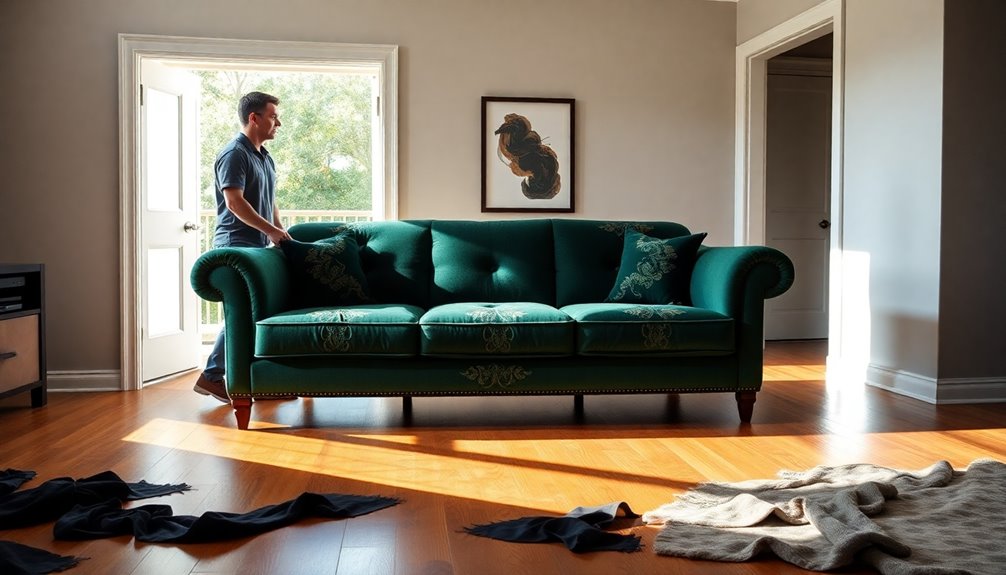
When choosing a custom fabric for your sofa, it's essential to consider both style and functionality. You have a range of custom fabric choices, including leather, microfiber, cotton, and linen, each offering unique aesthetics and comfort levels. If your household includes pets or children, high-performance fabrics like Crypton or Sunbrella are excellent options. These materials resist stains, moisture, and fading, ensuring your sofa stays looking fresh despite heavy use.
Pay attention to the durability rating of the fabrics. For high-traffic areas, opt for fabrics rated for heavy use; lighter fabrics might be better suited for more formal settings. Your fabric choice significantly affects the sofa's overall appearance and feel. For instance, plush velvet adds a luxurious touch, while canvas gives off a more casual vibe.
Custom upholstery often includes additional options such as color, pattern, and texture. This flexibility allows you to seamlessly match your sofa with your existing décor. By carefully selecting the right fabric, you can create a beautiful and functional piece that complements your lifestyle and enhances your living space.
Seasonal Storage Recommendations
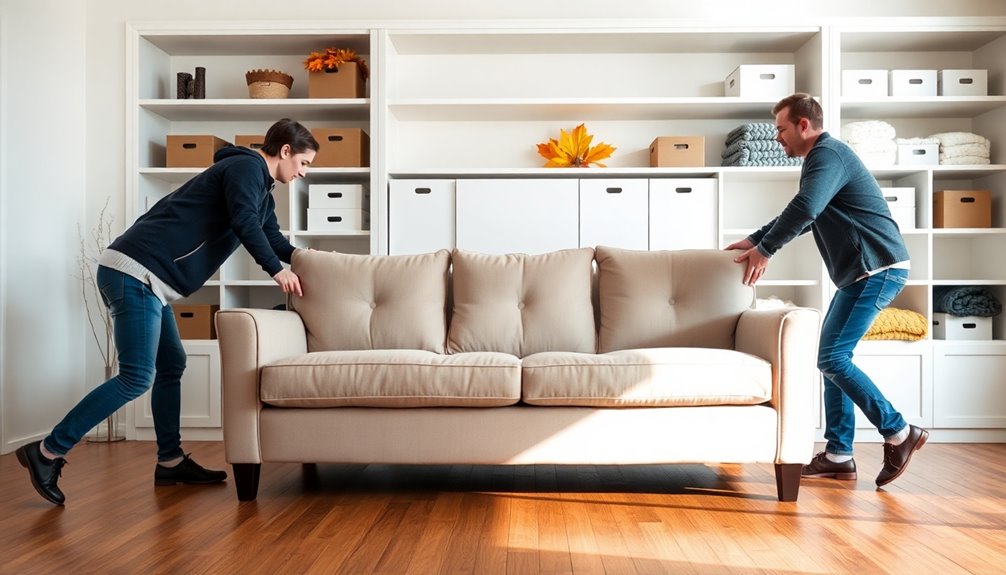
Properly storing your sofa during seasonal transitions can protect it from damage and keep it looking its best. Start by ensuring your sofa is thoroughly clean and completely dry. This step is crucial to prevent mold and mildew growth while in storage. Once clean, disassemble any removable parts, like legs or cushions, to save space and minimize the risk of damage.
Next, choose a climate-controlled environment for storage. Extreme temperatures and humidity can warp or damage your sofa's materials, so it's vital to keep it in a stable climate. Using breathable fabric covers instead of plastic is also essential; these covers protect your sofa from dust while allowing air circulation, which helps prevent moisture buildup.
Finally, elevate your sofa by placing it on a raised platform or pallets. This position avoids direct contact with the floor, reducing the risk of moisture absorption and damage. By following these seasonal storage recommendations, you'll not only protect your investment but also ensure your sofa remains in great condition for years to come.
Conclusion
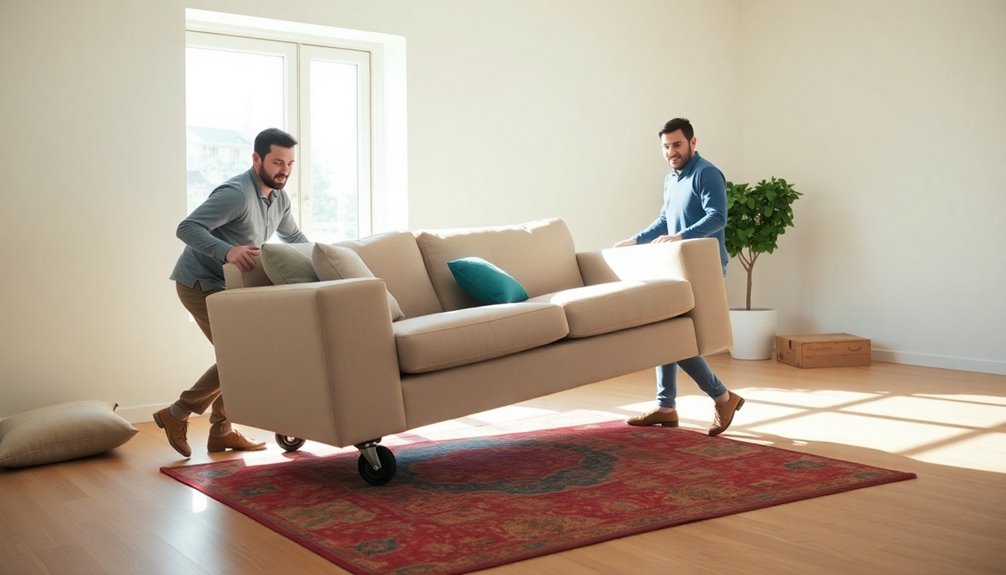
Successfully moving a sofa requires careful planning and execution to ensure it arrives at its destination safely and without damage. First, you need to prepare adequately by measuring dimensions and clearing pathways to avoid any injuries or mishaps. Disassembling the sofa into manageable parts can make it easier to move your couch, especially in tight corners and doorways. Protecting these pieces with moving blankets or shrink wrap will help prevent damage during transit.
Using the right moving equipment, like a furniture dolly or furniture sliders, will enhance your efficiency and safety when lifting heavy furniture. Don't forget to communicate clearly with your helpers; coordinated efforts are crucial when maneuvering through tight spaces.
If the task seems daunting, consider hiring professional movers. They can save you time, reduce physical strain, and minimize the risk of damaging your furniture or property. Ultimately, the key to a successful sofa move lies in preparation, the right tools, and possibly the expertise of professionals. By following these steps, you'll ensure that your sofa arrives at its new home in perfect condition, ready to be enjoyed.
Frequently Asked Questions
Can You Move a Sofa by Yourself?
Yes, you can move a sofa by yourself, but it's not as easy as it sounds. If your sofa's lightweight and you've got clear paths, you might manage it. Just make sure to measure doorways and hallways first to avoid getting stuck. Using furniture sliders helps, and a dolly can make lifting safer. Remember to use proper lifting techniques to protect your back. If it's too heavy, consider asking friends for help.
How Do You Move a Heavy Sofa Alone?
Moving a heavy sofa alone can be challenging, but you can make it easier. Start by using furniture sliders under each leg to glide it effortlessly. If possible, tilt the sofa diagonally to fit through tight spaces. Consider using moving straps to help distribute the weight, keeping your back safe. Always lift with your legs, not your back, and keep the sofa close to your body for better control and balance.
How to Move a Sofa Through a Doorway?
To move a sofa through a doorway, start by measuring both the sofa and the doorway to ensure a fit. Tilt the sofa diagonally to navigate it more easily. If possible, remove any legs or components to reduce height. Using furniture sliders or blankets can protect surfaces from scratches. Don’t forget to enlist a friend to help lift and guide the sofa, keeping it stable and preventing injury during the process. When fitting a sofa through a doorway, it’s important to maintain a steady grip while maneuvering it to avoid any sudden slips. If you encounter a tight spot, take a moment to reassess your approach and adjust the angle of the sofa as necessary. Lastly, be patient and communicate with your helper, as teamwork is crucial for successfully fitting a sofa through a doorway without damaging the furniture or the doorframe.
How Do I Move My Sofa?
To move your sofa, start by measuring its dimensions and ensuring it fits through doorways and hallways. Disassemble any removable parts to lighten the load. Use furniture sliders under the legs to glide it easily across the floor, and a dolly for heavier lifting. When navigating tight spaces, tilt the sofa and communicate with your helpers. Finally, secure it in the moving vehicle with tie-down straps to keep it safe during transport.
